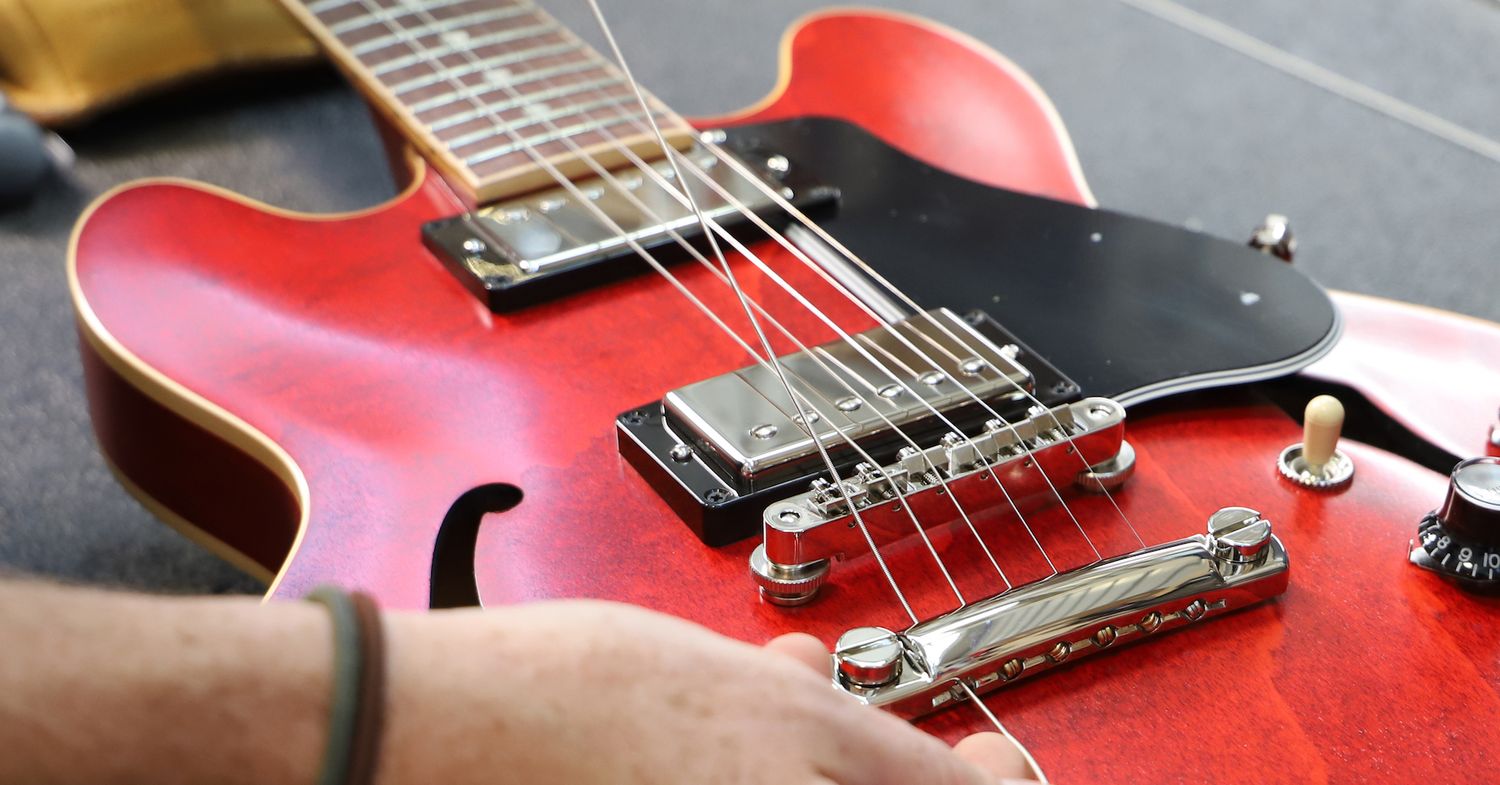Home>Instruments>Guitar>How Does A Guitar Make Sound


Guitar
How Does A Guitar Make Sound
Modified: February 15, 2024
Learn how a guitar produces sound and the science behind it. Understand the mechanics of how vibrations create music with a guitar.
(Many of the links in this article redirect to a specific reviewed product. Your purchase of these products through affiliate links helps to generate commission for AudioLover.com, at no extra cost. Learn more)
Table of Contents
Introduction
As one of the most popular and versatile musical instruments, the guitar has captured the hearts of millions of people around the world. Whether it’s the gentle strumming of an acoustic guitar or the electrifying riffs of an electric guitar, the instrument’s ability to produce captivating sounds is truly remarkable. In this article, we will delve into the fascinating realm of how a guitar creates sound, exploring the intricate interplay of its components and the physics behind its melodic resonance.
From the vibrating strings to the resonant body and the amplification of sound, each facet of the guitar contributes to its unique and enchanting sonic character. By understanding the mechanics of sound production in a guitar, we can gain a deeper appreciation for the instrument and the craftsmanship involved in its construction.
Join us on a captivating journey through the anatomy of the guitar, the physics of string vibration, the role of the guitar body in shaping sound, and the amplification techniques that bring forth its melodic prowess. By the end of this exploration, you’ll have a newfound understanding of the captivating magic that allows a guitar to resonate with such soul-stirring beauty.
The Anatomy of a Guitar
Before we unravel the mysteries of how a guitar produces sound, let’s take a closer look at its fundamental structure. A typical guitar comprises several key components, each playing a crucial role in the generation and projection of sound.
The headstock, located at the top of the guitar, houses the tuning pegs, which enable the player to adjust the tension of the strings, thereby altering their pitch. Moving along the neck, we encounter the frets, small metal strips embedded along the fretboard. Pressing the strings against different frets changes their vibrating length, producing varied pitches.
The body of the guitar, often crafted from tonewoods such as spruce, mahogany, or maple, serves as the resonating chamber that amplifies the sound produced by the strings. The sound hole, found on acoustic guitars, allows the reverberations within the body to escape, contributing to the instrument’s rich and full-bodied sound.
At the opposite end of the body, we find the bridge, a critical component that anchors the strings in place and transmits their vibrations to the body. The strings, usually made of steel or nylon, are the primary source of sound production, as their vibrations set the entire instrument in motion, creating the melodic tones that define the guitar’s allure.
Understanding the intricate interplay of these components is essential to comprehending how a guitar harnesses the physics of sound to produce its enchanting melodies. Now that we’ve acquainted ourselves with the guitar’s anatomy, let’s venture into the captivating realm of string vibration and its role in sound production.
How Strings Produce Sound
The soul-stirring melodies emanating from a guitar find their origins in the mesmerizing dance of the strings. When a guitarist plucks a string, it is set into motion, executing a graceful oscillation that generates the fundamental frequencies responsible for producing sound.
As the string vibrates, it creates compressions and rarefactions in the surrounding air, giving rise to sound waves that travel through the air and reach our ears. The frequency of these vibrations determines the pitch of the sound produced, with higher frequencies yielding higher pitches and vice versa.
Furthermore, the length, tension, and mass of the string collectively influence the pitch it produces. By altering the length of the vibrating portion, achieved through pressing the string against different frets, the guitarist can produce a diverse array of notes. Adjusting the tension of the string, typically done through tuning pegs, also modulates the pitch, offering further control over the produced sound.
It’s fascinating to note that the strings not only generate their fundamental frequencies but also produce harmonics, which are multiples of the fundamental frequency. These harmonics contribute to the complex and nuanced timbre of the guitar, enriching its sonic palette with overtones that add depth and character to the sound.
Through the mesmerizing interplay of tension, length, and mass, the guitar strings orchestrate a symphony of frequencies, giving rise to the captivating melodies that have enraptured music enthusiasts for generations. Now that we’ve unraveled the enchanting secrets of string vibration, let’s venture deeper into the role of the guitar body in shaping and amplifying these melodious vibrations.
The Role of the Guitar Body
While the strings serve as the primary source of sound production, the guitar body plays a pivotal role in shaping and amplifying the vibrations emanating from the strings. Crafted from carefully selected tonewoods, the body of the guitar serves as a resonating chamber, harnessing the energy generated by the vibrating strings and enriching the sound with its unique tonal characteristics.
When the strings are set into motion, they transfer their vibrations to the bridge, which, in turn, transmits these vibrations to the soundboard – the guitar’s primary resonating surface. The soundboard, typically made from tonewoods renowned for their acoustic properties, such as spruce or cedar, effectively amplifies the vibrations, infusing the sound with warmth, richness, and resonance.
The shape and design of the guitar body also play a crucial role in determining the instrument’s tonal qualities. Whether it’s the sleek curves of an acoustic guitar or the contoured silhouette of an electric guitar, the body’s form influences the way sound waves reverberate within the instrument, contributing to the timbre and projection of the produced sound.
Additionally, the sound hole, a prominent feature of acoustic guitars, serves as an acoustic portal, allowing the reverberations within the body to escape and mingle with the surrounding air. This process not only enhances the volume and projection of the sound but also contributes to the distinctive tonal character of the instrument.
Through the harmonious collaboration of the vibrating strings and the resonant body, the guitar produces a symphony of captivating sounds, each note imbued with the instrument’s unique tonal fingerprint. As we continue our exploration, we will delve into the techniques of amplification and sound projection, unveiling the mechanisms that elevate the guitar’s melodic prowess to new heights.
Amplification and Sound Projection
While acoustic guitars rely on their hollow bodies to amplify sound, electric guitars harness the power of amplifiers and pickups to project their melodic prowess. Amplification plays a pivotal role in enhancing the volume and tonal characteristics of the guitar, allowing musicians to enrapture audiences in diverse settings, from intimate gatherings to grand concert halls.
Acoustic guitars, with their resonant bodies, naturally produce a rich and full-bodied sound. However, in larger venues or amidst competing sounds, amplification becomes indispensable. Acoustic-electric guitars, equipped with built-in pickups, can be connected to acoustic amplifiers or PA systems, ensuring that their melodious resonance reaches every corner of the venue with pristine clarity and depth.
Electric guitars, on the other hand, rely on pickups to capture the vibrations of the strings and convert them into electrical signals. These signals are then channeled through amplifiers, where they are transformed into powerful sound waves that reverberate through speakers. The diverse array of amplifiers and effects pedals available to electric guitarists allows for an unparalleled level of sonic manipulation, enabling them to sculpt their desired tones with precision and artistry.
Furthermore, the art of sound projection extends beyond amplification, encompassing the techniques employed by guitarists to ensure that their melodies reach the ears of their audience with utmost clarity and impact. From the delicate nuances of fingerpicking to the thunderous power of strumming, guitarists masterfully wield their instruments to project their musical expressions with finesse and emotion.
Whether it’s the captivating resonance of an acoustic guitar reverberating through a concert hall or the electrifying riffs of an electric guitar igniting a stadium, the art of amplification and sound projection elevates the guitar’s melodic allure to breathtaking heights. As we conclude our exploration, let’s reflect on the captivating journey we’ve embarked upon, gaining a deeper understanding of the mesmerizing magic that allows a guitar to resonate with such soul-stirring beauty.
Conclusion
Embarking on this captivating exploration of how a guitar produces sound has unveiled the enchanting mechanisms that underpin the instrument’s melodic allure. From the mesmerizing dance of the strings to the resonant embrace of the guitar body, each facet of the instrument harmonizes to create a symphony of captivating sounds that have enraptured music enthusiasts for generations.
As we delved into the anatomy of the guitar, we uncovered the crucial role played by each component in shaping the instrument’s sonic character. The vibrating strings, meticulously crafted body, and resonant sound hole all contribute to the guitar’s rich and diverse tonal palette, infusing each note with a unique timbral fingerprint.
Furthermore, our journey into the realm of string vibration illuminated the intricate interplay of tension, length, and mass, unveiling the mesmerizing physics that orchestrate the guitar’s soul-stirring melodies. The harmonics and overtones produced by the strings add depth and character to the instrument’s sonic tapestry, enriching its expressive potential with a kaleidoscope of tonal hues.
Exploring the art of amplification and sound projection further unveiled the versatility and dynamism of the guitar. Whether through the resonant chambers of acoustic guitars or the electrifying realms of electric guitars and amplifiers, the instrument’s melodic prowess transcends boundaries, enrapturing audiences with its captivating resonance and emotive power.
As we conclude our odyssey through the captivating world of guitar sound production, let’s carry with us a newfound appreciation for the craftsmanship, physics, and artistry that converge to imbue this instrument with such soul-stirring beauty. Whether you’re a seasoned guitarist or an avid enthusiast, may the melodies of the guitar continue to inspire and uplift, resonating with the timeless magic that defines this beloved instrument.











